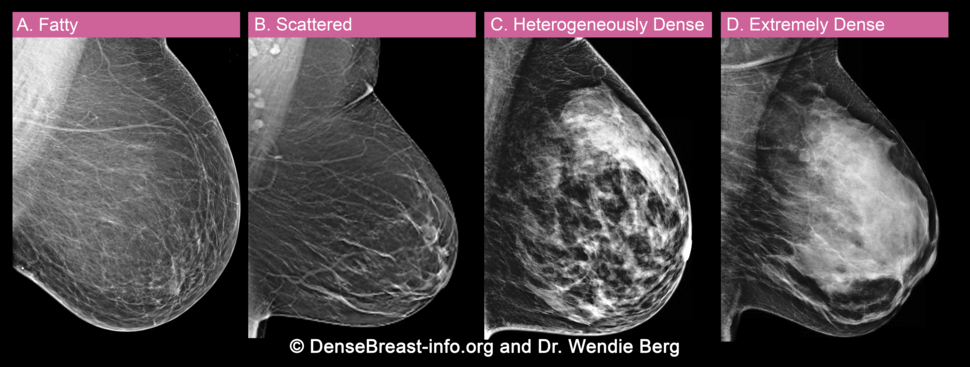The FDA wants to make women aware of their breast density.
If you’re a woman over the age of 50, or have been told you’re at a higher risk of getting breast cancer, it’s likely that you have been invited to attend a Breast Screening. At these screenings, your breasts are placed on a special type of x-ray which scan the inside of your breasts, allowing mammographers to look for tumours and other abnormalities.
Once the x-ray has been taken, the mammographer will produce an image of your breast, made up of what looks like a variety of light and dark areas. These are the different types of tissue that can be found in the breast, the darker areas being your fatty tissue, and the lighter areas being your desner, more fibrous tissue. Women with dense breasts will have more white areas than those with less dense breasts. Picture a typical x-ray image of a broken bone – because bone is dense, it appears white. This is the same for fibrous tissue found in the breast because it is harder for the x-rays to pass through.
As of a few weeks ago, the FDA made it mandatory for Breast Screening Facilities in the US to discuss individual breast density with patients from September 10th, 2024. This notification will indicate whether you have ‘dense’ or ‘not dense’ breasts. More detailed information will then be passed on to the necessary health care providers so appropriate steps can be taken to assess individual risk of developing breast cancer based on the mammographer’s report.
What is breast density?
Breast density is a measure of how much fibrous and glandular tissue is in your breasts. It’s not related to how big or firm your breasts are. The white areas on a mammogram are dense areas of tissue in the breast. Meanwhile, the darker areas indicate more glandular and fatty tissue.
Breast density tends to decrease with age, meaning younger women generally have higher breast density. In most cases breast density will decrease with age, especially after menopause. However, some conditions and medications can result in breasts remaining dense even at old age. Your GP should always consult you on any medications that may put you at a higher risk of increased breast density.
Why is knowing your breast density important?
Having dense breasts can make it harder to detect breast cancer and other abnormalities on a mammogram. This is because dense tissue can look similar to cancer on a mammogram. Knowing your breast density will help you and your healthcare provider to take the appropriate course of action to ensure early detection, and prevent the development of breast cancer. In instances where you have been identified as having higher breast density, further scans such as MRIs and ultrasounds can be used for a more detailed look into your breast tissue.
Want to learn more about breast density?
We encourage you to read on and learn more about breast density, and how it plays a role in breast cancer detection. You can find more information on the National Cancer Institute’s website: https://www.cancer.gov/types/breast/breast-changes/dense-breasts
By understanding your breast density, you can take steps to protect your health and detect breast cancer early.




![NHS Innovation Accelerator Logo 2024 [White, Transparent Background]-min NHS Innovation Accelerator Logo 2024 [White, Transparent Background]-min](https://wewearboost.com/wp-content/uploads/2022/05/NHS-Innovation-Accelerator-Logo-2024-White-Transparent-Background-min.png)

